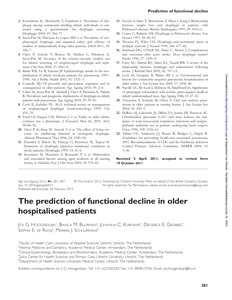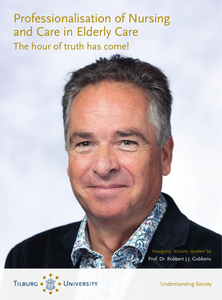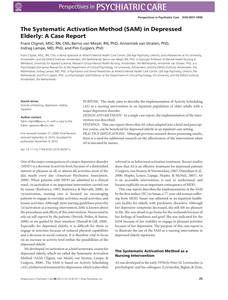As the population ages, the risk of becoming malnourished increases. Research has shown that poor oral health can be a risk factor for malnutrition in institutionalized elderly. However, it remains unclear whether oral health problems, edentulousness and health-related quality of life also pose a risk for malnutrition in community-dwelling older adults. In this cross-sectional observational study, 1325 community-living elderly (≥75 years) were asked to complete questionnaires regarding nutritional status, oral status (edentulous, remaining teeth, or implant-supported overdentures), oral health problems, health-related quality of life (HRQoL), frailty, activities of daily living (ADL) and complexity of care needs. Univariate and multivariate logistic regression analyses were performed with nutritional status as dependent variable. Of the respondents, 51% (n = 521) were edentulous, 38.8% (n = 397) had remaining teeth and 10.2% (n = 104) had an implant-supported overdenture. Elderly with complex care needs were malnourished most frequently, followed by frail and robust elderly (10%, 4.5% and 2.9%, respectively). Malnourished elderly reported more frequent problems with chewing and speech when compared with well-nourished elderly (univariate analysis). However, multivariate analysis did not show an association between malnutrition and oral health problems and edentulousness, although HRQoL was associated with malnutrition (odds ratio (OR) 0.972, confidence interval (CI) 0.951–0.955). Based on the results of this cross-sectional study, it can be concluded that poor HRQoL is significantly associated with malnutrition; however, edentulousness and oral health problems are not.
DOCUMENT

BACKGROUND: The primary aim of this study was to assess the outcome of elderly intensive care unit (ICU) patients treated during the spring and autumn COVID-19 surges in Europe.METHODS: This was a prospective European observational study (the COVIP study) in ICU patients aged 70 years and older admitted with COVID-19 disease from March to December 2020 to 159 ICUs in 14 European countries. An electronic database was used to register a number of parameters including: SOFA score, Clinical Frailty Scale, co-morbidities, usual ICU procedures and survival at 90 days. The study was registered at ClinicalTrials.gov (NCT04321265).RESULTS: In total, 2625 patients were included, 1327 from the first and 1298 from the second surge. Median age was 74 and 75 years in surge 1 and 2, respectively. SOFA score was higher in the first surge (median 6 versus 5, p < 0.0001). The PaO2/FiO2 ratio at admission was higher during surge 1, and more patients received invasive mechanical ventilation (78% versus 68%, p < 0.0001). During the first 15 days of treatment, survival was similar during the first and the second surge. Survival was lower in the second surge after day 15 and differed after 30 days (57% vs 50%) as well as after 90 days (51% vs 40%).CONCLUSION: An unexpected, but significant, decrease in 30-day and 90-day survival was observed during the second surge in our cohort of elderly ICU patients. The reason for this is unclear. Our main concern is whether the widespread changes in practice and treatment of COVID-19 between the two surges have contributed to this increased mortality in elderly patients. Further studies are urgently warranted to provide more evidence for current practice in elderly patients.TRIAL REGISTRATION NUMBER: NCT04321265 , registered March 19th, 2020.
MULTIFILE
Objective. To investigate the feasibility and effects of additional preoperative high intensity strength training for patients awaiting total knee arthroplasty (TKA). Design. Clinical controlled trial. Patients. Twenty-two patients awaiting TKA. Methods. Patients were allocated to a standard training group or a group receiving standard training with additional progressive strength training for 6 weeks. Isometric knee extensor strength, voluntary activation, chair stand, 6-minute walk test (6MWT), and stair climbing were assessed before and after 6 weeks of training and 6 and 12 weeks after TKA. Results. For 3 of the 11 patients in the intensive strength group, training load had to be adjusted because of pain. For both groups combined, improvements in chair stand and 6MWT were observed before surgery, but intensive strength training was not more effective than standard training. Voluntary activation did not change before and after surgery, and postoperative recovery was not different between groups (P > 0.05). Knee extensor strength of the affected leg before surgery was significantly associated with 6-minute walk (r = 0.50) and the stair climb (r - = 0.58, P < 0.05). Conclusion. Intensive strength training was feasible for the majority of patients, but there were no indications that it is more effective than standard training to increase preoperative physical performance. This trial was registered with NTR2278.
DOCUMENT
Thirty to sixty per cent of older patients experience functional decline after hospitalisation, associated with an increase in dependence, readmission, nursing home placement and mortality. First step in prevention is the identification of patients at risk. The objective of this study is to develop and validate a prediction model to assess the risk of functional decline in older hospitalised patients.
DOCUMENT

Inaugural lecture, delivered upon public acceptance of the endowed professorship in Professionalisation of Nursing and Care in Elderly Care by Prof. Dr. Robbert J.J. Gobbens at Tilburg University on 29 September 2023.
DOCUMENT

BACKGROUND: Depression in later life is a common mental disorder with a prevalence rate of between 3% and 35% for minor depression and approximately 2% for Major Depressive Disorder (MDD). The most common treatment modalities for MDD are antidepressant medication and psychological interventions. Recently, Behavioral Activation (BA) has gained renewed attention as an effective treatment modality in MDD. Although BA is considered an easy accessible intervention for both patients and health care workers (such as nurses), there is no research on the effectiveness of the intervention in inpatient depressed elderly.The aim of study, described in the present proposal, is to examine the effects of BA when executed by nurses in an inpatient population of elderly persons with MDD. METHODS/DESIGN: The study is designed as a multi-center cluster randomized controlled trial. BA, described as The Systematic Activation Method (SAM) will be compared with Treatment as Usual (TAU). We aim to include ten mental health care units in the Netherlands that will each participate as a control unit or an experimental unit. The patients will meet the following criteria: (1) a primary diagnosis of Major Depressive Disorder (MDD) according to the DSM-IV criteria; (2) 60 years or older; (3) able to read and write in Dutch; (4) have consented to participate via the informed consent procedure. Based on an effect size d = 0.7, we intend to include 51 participants per condition (n = 102). The SAM will be implemented within the experimental units as an adjunctive therapy to Treatment As Usual (TAU). All patients will be assessed at baseline, after eight weeks, and after six months. The primary outcome will be the level of depression measured by means of the Beck Depression Inventory (Dutch version). Other assessments will be activity level, mastery, costs, anxiety and quality of life. DISCUSSION: To our knowledge this is the first study to test the effect of Behavioral Activation as a nursing intervention in an inpatient elderly population. This research has been approved by the medical research ethics committee for health-care settings in the Netherlands (No. NL26878.029.09) and is listed in the Dutch Trial Register (NTR No.1809).
DOCUMENT

In this paper we investigate the precise focus required of a telemonitoring system for the domain of independently living elderly. Particularly, we investigate (1) the needs of telemonitoring for this particular domain, and (2) the requirements for such a telemonitoring system. For our investigation, we performed an extensive study of the literature, as well as performed interviews with 36 individuals active in the field. As a result, we established numerous needs to be considered, being foremost information need on safety, with regard to care response on emergencies (e.g., falling incidents, wandering), as well information need on dependence on care, with regard to inactivity, self-neglect and loneliness. Subsequently, we established numerous requirements to be addressed, being foremost the use of non-wearable sensors, unobtrusiveness, durability, reliability, privacy, and ubiquitousness. In our discussion of the requirements, we detailed specifically the topics of focus, functionality, and form of a telemonitoring system for this domain.
DOCUMENT

A Dutch healthcare organisation modernizes its real estate portfolio to meet today’s requirements and acquired an office building for conversion into a nursing home for elderly with dementia. The purpose of the research has been to study the design principles for elderly with dementia, for innovative and smart application in work processes and the acquired building.Methods – Using multiple-method qualitative research design, bachelor thesis students of a university of applied sciences explored the reconstruction of the acquired building and related healthcare processes. Results – Application of design principles for the elderly with dementia were studied, among which were interior design, catering process, and connection with the neighbourhood. Feasible interior ideas were elaborated, intentions for change in the catering process were confirmed by stakeholders, and an action plan for neighbourhood connections was delivered. Elements are being used for a final design. Implementation has to be checked with close scrutiny.Originality – The application of design principles for elderly with dementia (design, favourable state, beautiful moments) together with changes in work processes of health care employees aiming at patient-centred care is a new combination. Practical or social implications – When a healthcare organisation chooses a new care concept, not only the surroundings change. Also, the processes around people and the way we take care of them change. In many ways a new concept can only succeed when the employees and the way they work change as well.
MULTIFILE

Home rehabilitation after a hip operation can be daunting for the elderly. Lack of motivation to exercise and being insecure in the recovery process are common barriers. Personalized eHealth can help to ensure that the patient exercise efficiently, filling the gap between treatment in the practice with the physical therapist and practice at home.
DOCUMENT

The study aims to describe the implementation of Activity Scheduling (AS) as a nursing intervention in an inpatient population of older adults with a major depressive disorder. DESIGN AND METHODS: In a single case report, the implementation of the intervention was described. FINDINGS: This case report shows that AS, when adapted into a brief and prescriptive course, can be beneficial for depressed elderly in an inpatient care setting. PRACTICE IMPLICATIONS: Although previous research shows promising results, there is a need for additional research on the effectiveness of the intervention when AS is executed by nurses.
DOCUMENT
